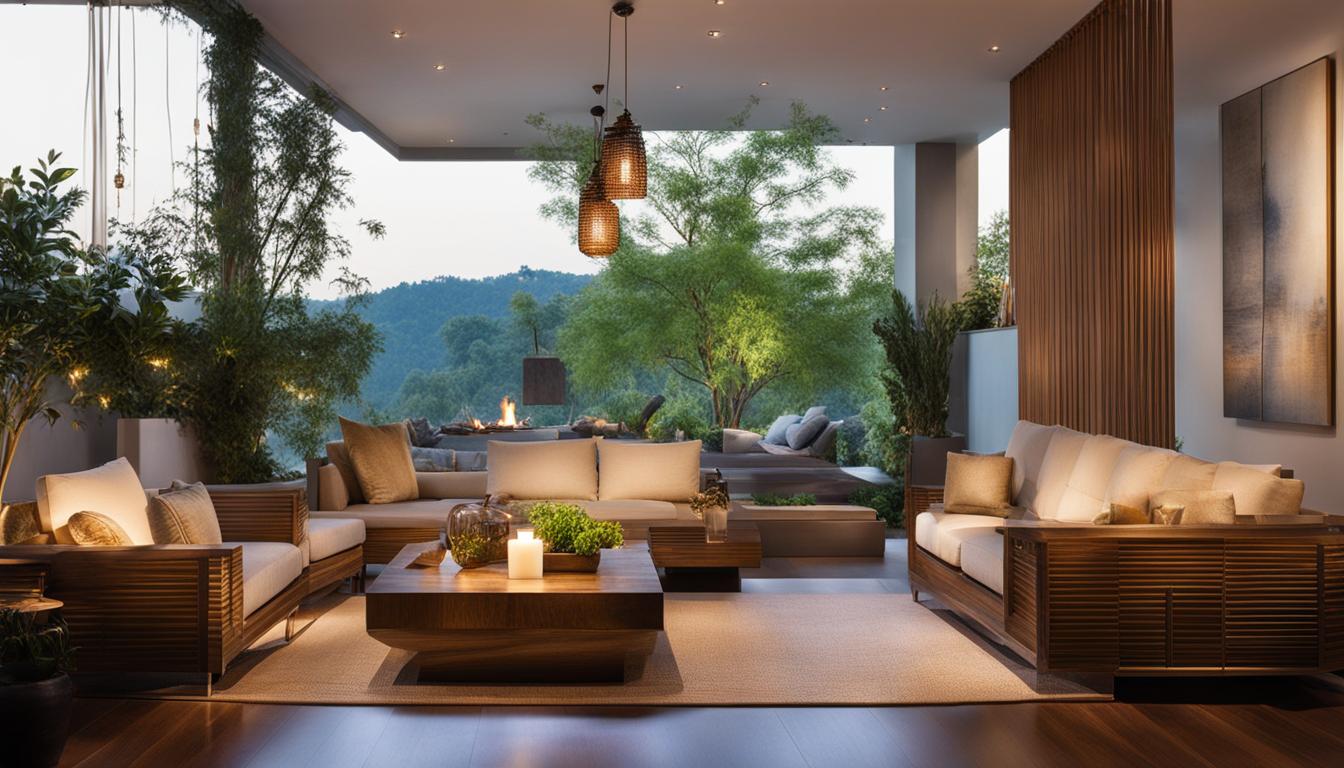Your living room is not just a space for relaxation and entertainment; it can significantly impact your overall wellbeing. The ancient Chinese practice of Feng Shui offers valuable insights on how to create a harmonious and prosperous living space.
By making a few simple changes to your living room layout, you can improve the flow of energy, reduce stress, and foster positive energy.
In this section, we will explore different Feng Shui living room layouts that can help improve your overall wellbeing. Discover how arranging your furniture, choosing the right color scheme, incorporating plants, and properly placing mirrors and lighting can create a harmonious and prosperous living space.
Key Takeaways:
- Feng Shui principles offer valuable insights on how to create a harmonious living space.
- Your living room can significantly impact your overall wellbeing.
- Arranging your furniture, choosing the right color scheme, incorporating plants, and properly placing mirrors and lighting are key to creating a harmonious and prosperous living space.
- By making a few simple changes to your living room layout, you can improve the flow of energy, reduce stress, and foster positive energy.
- Implementing Feng Shui principles in your living room can greatly enhance your overall wellbeing.
How to Create a Feng Shui Living Room
If you’re looking to create a calming and serene living space, incorporating Feng Shui principles can help. Here are some living room Feng Shui tips to get you started:
- Declutter: A cluttered living room can lead to a cluttered mind. Clear out any unnecessary items and ensure your furniture arrangement allows for easy movement and flow.
- Find the right furniture: Choose pieces that bring you joy and are in good condition. Select furniture that is the appropriate size for your living room, and position it in a way that promotes positive energy flow.
- Balance energy flow: Ensure your living room has a balanced energy flow by placing furniture in the right locations. Avoid blocking doorways and windows and use items like rugs and curtains to soften sharp corners.
- Use natural elements: Incorporate natural elements like plants and stones in your living room design. Plants oxygenate the air and bring a calming energy to the space.
- Include soft lighting: Soft lighting can enhance the ambiance of your living room. Use lamps and dimmer switches to create a calming atmosphere in the evening.
- Avoid sharp angles: Sharp angles can create negative energy, so choose furniture with rounded corners instead. Avoid placing furniture in pointed positions in your living room.
By following these living room Feng Shui tips, you can create a relaxing and harmonious space that promotes positive energy flow and enhances your overall wellbeing.
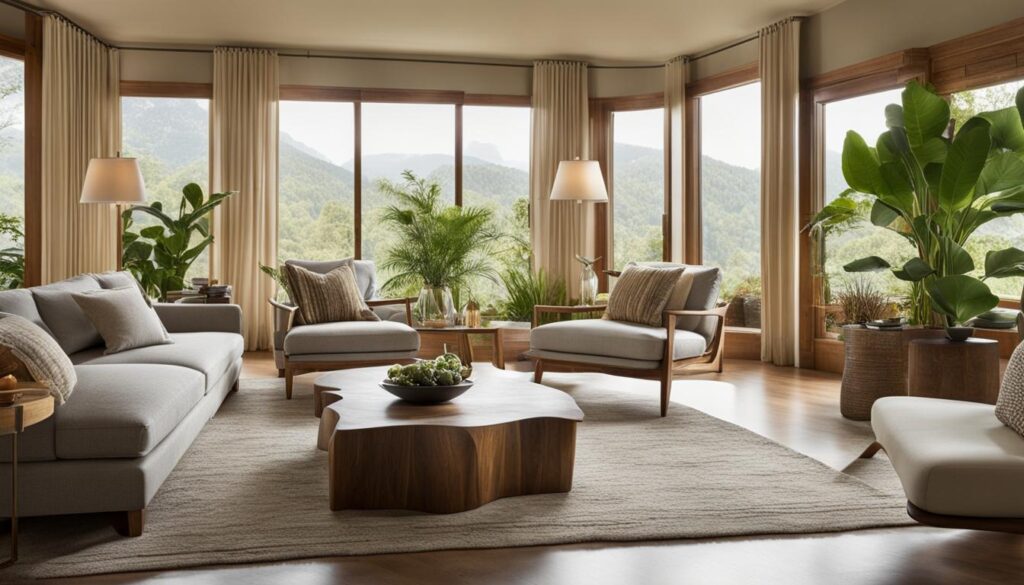
Enhancing Energy Flow with Feng Shui Furniture Arrangement
One of the essential principles of Feng Shui is creating a harmonious flow of energy in your living space. Furniture placement plays a crucial role in achieving this. By arranging your furniture in a way that promotes a balanced energy flow, you can create a sense of peace and tranquility in your living room. Here are some tips on Feng Shui furniture arrangement:
- Find the focal point: When arranging your furniture, start by identifying the focal point of your living room. This could be a fireplace, a window with a stunning view, or a piece of artwork. Arrange your furniture around this focal point to create a cozy and inviting atmosphere.
- Create a conversation area: Position your sofas and chairs in a way that encourages conversation and socializing. Avoid placing chairs with their backs to others, as it creates a sense of disconnect. Instead, arrange your seating in a way that promotes interaction and connection.
- Allow for easy movement: Ensure that there is enough space for people to move around the room without obstacles. Avoid placing furniture in the middle of the room or in high traffic areas, as it creates a sense of discomfort and unease.
- Aim for balance: Achieving balance is key in Feng Shui furniture arrangement. Balance can be created by placing furniture of similar size and weight on opposite sides of the room. This creates a harmonious energy flow that promotes relaxation and peace.
- Avoid sharp corners: Sharp corners create negative energy in your living space. If possible, choose furniture with rounded edges or use corner protectors to soften the edges. This promotes a sense of safety and comfort in your living room.
Implementing these Feng Shui furniture arrangement tips can create a harmonious and balanced energy flow in your living room. By taking the time to arrange your furniture in a mindful way, you can create a space that promotes relaxation and prosperity.
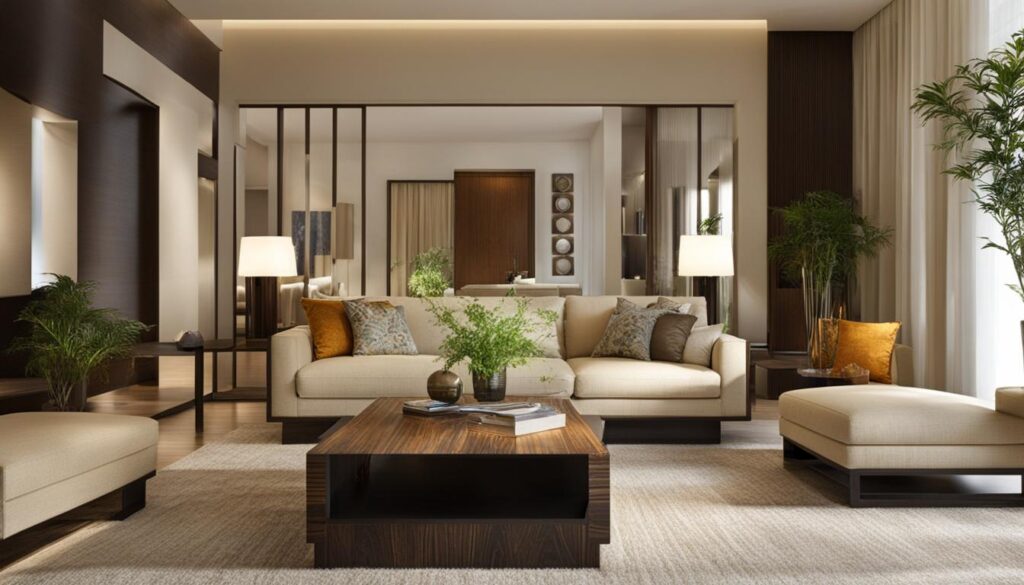
Choosing the Right Color Scheme for Your Feng Shui Living Room
The colors you choose for your living room can significantly impact the energy flow and overall ambiance of the space. When it comes to Feng Shui, certain colors are believed to promote relaxation, balance, and positive energy in your living room. So, it’s important to choose the right color scheme for your Feng Shui living room.
The first step is to choose a primary color for your living room. This color will set the tone for the entire space. If you want to create a calming and relaxing atmosphere, blue or green might be the perfect primary color. If you want to promote creativity and inspiration, consider using shades of yellow or orange.
Once you’ve chosen your primary color, it’s time to find complementary colors that will enhance the overall energy flow of your living room. Earthy tones such as beige, brown, and cream are often used in Feng Shui to promote stability and grounding. Metallic colors such as gold and silver can be used as accents to bring a sense of luxury and abundance to your living room.
When choosing your color scheme, it’s important to avoid using too many bold or bright colors as they can be distracting and overwhelming. Instead, opt for muted or pastel shades that will create a soothing and harmonious living space.
- Blue: Associated with tranquility, calmness, and clarity.
- Green: Promotes growth, balance, and harmony.
- Yellow: Evokes feelings of happiness, optimism, and creativity.
- Orange: Promotes enthusiasm, creativity, and stimulation.
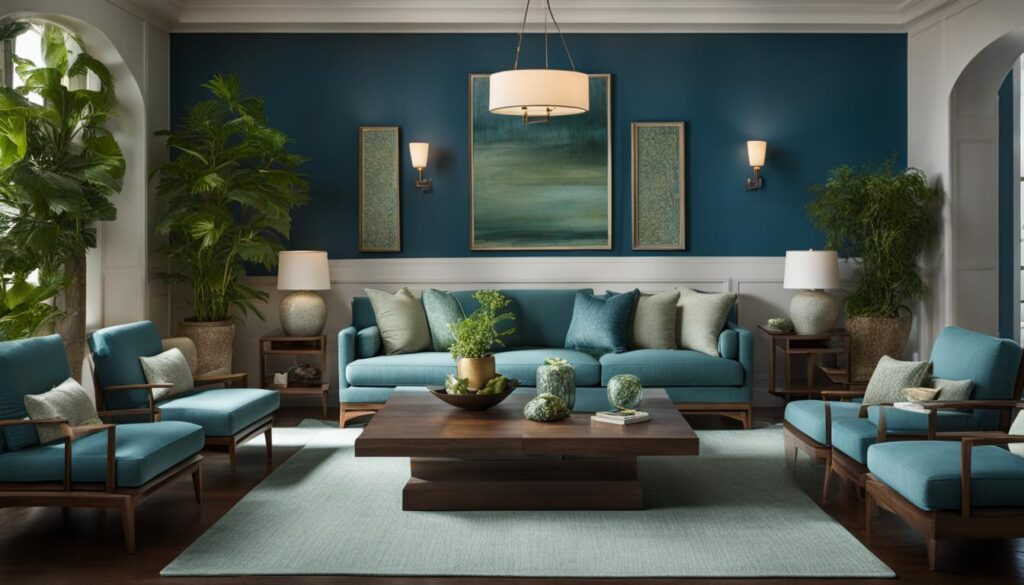
By choosing the right color scheme for your Feng Shui living room, you can create a space that promotes positive energy and enhances your overall sense of wellbeing. Remember to keep it simple, use muted or pastel shades, and incorporate earthy and metallic accents for balance. With these tips, you’ll be on your way to creating a harmonious and prosperous living space.
Enhancing Your Feng Shui Living Room with Decor, Plants, Mirrors, and Lighting
Now that you have established a balanced furniture arrangement and cohesive color scheme, it’s time to enhance your Feng Shui living room with decor, plants, mirrors, and lighting. These elements can greatly impact the energy flow of your space and create a serene atmosphere that promotes positivity and relaxation.
Feng Shui Living Room Decor: When selecting decor for your living room, choose items that reflect your personal style while also promoting positive energy. Avoid clutter, which can disrupt the flow of energy. Opt for simple decor pieces, such as candles, throw pillows, or artwork, that complement your color scheme and create a sense of tranquility.
Feng Shui Living Room Plants: Plants are essential for adding life and vitality to your living room. They also purify the air and bring positive energy to your space. Select plants that thrive in low-light conditions, such as snake plants, peace lilies, or bamboo palms. Place them in the corners of your living room to promote optimal energy flow.
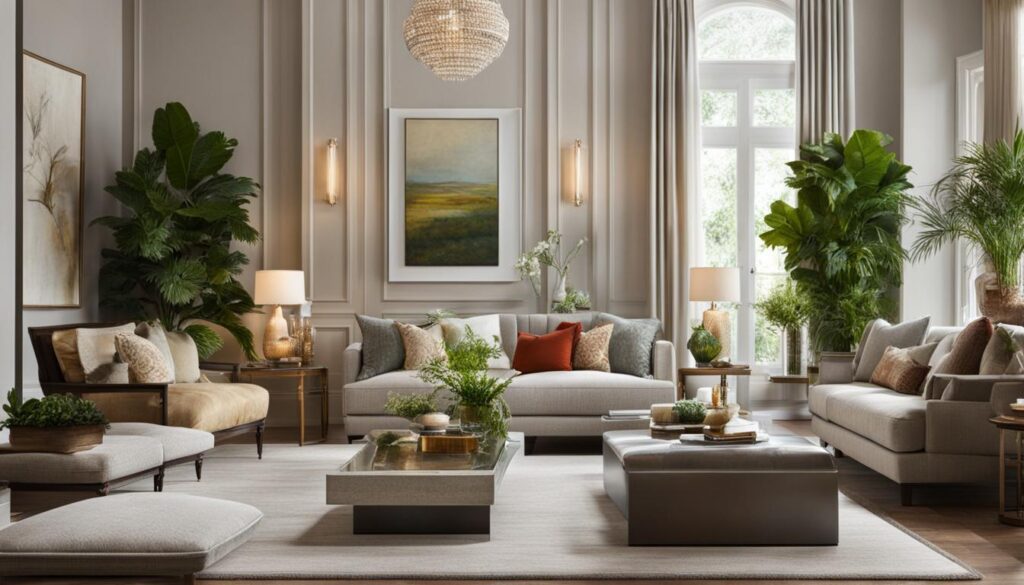
Feng Shui Living Room Mirror Placement: Mirrors can be used to reflect light and energy in your living room. However, it’s crucial to place them strategically to avoid disrupting the energy flow. Hang mirrors on the walls perpendicular to windows to reflect natural light. Avoid hanging them directly facing doors, as this can cause energy to bounce back out of the room.
Feng Shui Living Room Lighting: Lighting plays a significant role in Feng Shui. The ideal lighting for a living room is a combination of natural light and soft ambient lighting. Use window treatments that allow natural light to enter the room, but avoid harsh direct sunlight. Incorporate soft lighting elements, such as table lamps or floor lamps, to create a soothing atmosphere.
By incorporating these Feng Shui elements into your living room, you can create a space that promotes positivity, relaxation, and overall wellbeing.
Conclusion
Congratulations on taking the first step towards creating a harmonious and prosperous living space! By implementing Feng Shui principles in your living room, you can transform it into a sanctuary where you can relax and recharge.
Remember to declutter your space and find the right furniture arrangement to create a balanced flow of energy. Choose a color scheme that promotes relaxation, balance, and positive energy, and incorporate plants, decor, mirrors, and lighting to enhance your living room’s energy.
With these tips and techniques, you can unlock the full potential of your Feng Shui living room and improve your overall well-being. Enjoy the positive energy and peaceful atmosphere of your newly designed living room!

